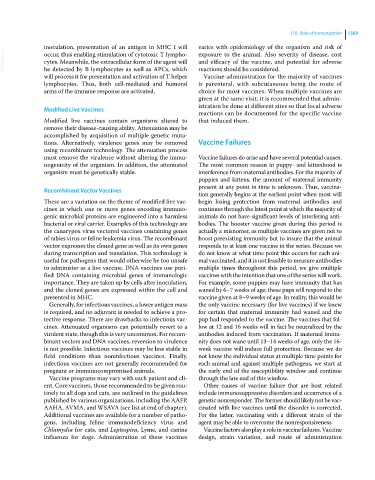Page 1631 - Clinical Small Animal Internal Medicine
P. 1631
176 Role of Immunization 1569
inoculation, presentation of an antigen in MHC I will varies with epidemiology of the organism and risk of
VetBooks.ir occur, thus enabling stimulation of cytotoxic T lympho- exposure to the animal. Also severity of disease, cost
and efficacy of the vaccine, and potential for adverse
cytes. Meanwhile, the extracellular form of the agent will
be detected by B lymphocytes as well as APCs, which
Vaccine administration for the majority of vaccines
will process it for presentation and activation of T helper reactions should be considered.
lymphocytes. Thus, both cell‐mediated and humoral is parenteral, with subcutaneous being the route of
arms of the immune response are activated. choice for most vaccines. When multiple vaccines are
given at the same visit, it is recommended that admin-
istration be done at different sites so that local adverse
Modified Live Vaccines
reactions can be documented for the specific vaccine
Modified live vaccines contain organisms altered to that induced them.
remove their disease‐causing ability. Attenuation may be
accomplished by acquisition of multiple genetic muta-
tions. Alternatively, virulence genes may be removed Vaccine Failures
using recombinant technology. The attenuation process
must remove the virulence without altering the immu- Vaccine failures do arise and have several potential causes.
nogenicity of the organism. In addition, the attenuated The most common reason in puppy‐ and kittenhood is
organism must be genetically stable. interference from maternal antibodies. For the majority of
puppies and kittens, the amount of maternal immunity
present at any point in time is unknown. Thus, vaccina-
Recombinant Vector Vaccines
tion generally begins at the earliest point when most will
These are a variation on the theme of modified live vac- begin losing protection from maternal antibodies and
cines in which one or more genes encoding immuno- continues through the latest point at which the majority of
genic microbial proteins are engineered into a harmless animals do not have significant levels of interfering anti-
bacterial or viral carrier. Examples of this technology are bodies. The booster vaccine given during this period is
the canarypox virus vectored vaccines containing genes actually a misnomer, as multiple vaccines are given not to
of rabies virus or feline leukemia virus. The recombinant boost preexisting immunity but to insure that the animal
vector expresses the cloned gene as well as its own genes responds to at least one vaccine in the series. Because we
during transcription and translation. This technology is do not know at what time point this occurs for each ani-
useful for pathogens that would otherwise be too unsafe mal vaccinated, and it is not feasible to measure antibodies
to administer as a live vaccine. DNA vaccines use puri- multiple times throughout this period, we give multiple
fied DNA containing microbial genes of immunologic vaccines with the intention that one of the series will work.
importance. They are taken up by cells after inoculation, For example, some puppies may have immunity that has
and the cloned genes are expressed within the cell and waned by 6–7 weeks of age; these pups will respond to the
presented in MHC. vaccine given at 8–9 weeks of age. In reality, this would be
Generally, for infectious vaccines, a lower antigen mass the only vaccine necessary (for live vaccines) if we knew
is required, and no adjuvant is needed to achieve a pro- for certain that maternal immunity had waned and the
tective response. There are drawbacks to infectious vac- pup had responded to the vaccine. The vaccines that fol-
cines. Attenuated organisms can potentially revert to a low at 12 and 16 weeks will in fact be neutralized by the
virulent state, though this is very uncommon. For recom- antibodies induced from vaccination. If maternal immu-
binant vectors and DNA vaccines, reversion to virulence nity does not wane until 13–14 weeks of age, only the 16‐
is not possible. Infectious vaccines may be less stable in week vaccine will induce full protection. Because we do
field conditions than noninfectious vaccines. Finally, not know the individual status at multiple time points for
infectious vaccines are not generally recommended for each animal and against multiple pathogens, we start at
pregnant or immunocompromised animals. the early end of the susceptibility window and continue
Vaccine programs may vary with each patient and cli- through the late end of this window.
ent. Core vaccines, those recommended to be given rou- Other causes of vaccine failure that are host related
tinely to all dogs and cats, are outlined in the guidelines include immunosuppressive disorders and occurrence of a
published by various organizations, including the AAFP, genetic nonresponder. The former should likely not be vac-
AAHA, AVMA, and WSAVA (see list at end of chapter). cinated with live vaccines until the disorder is corrected.
Additional vaccines are available for a number of patho- For the latter, vaccinating with a different strain of the
gens, including feline immunodeficiency virus and agent may be able to overcome the nonresponsiveness.
Chlamydia for cats, and Leptospira, Lyme, and canine Vaccine factors also play a role in vaccine failures. Vaccine
influenza for dogs. Administration of these vaccines design, strain variation, and route of administration

